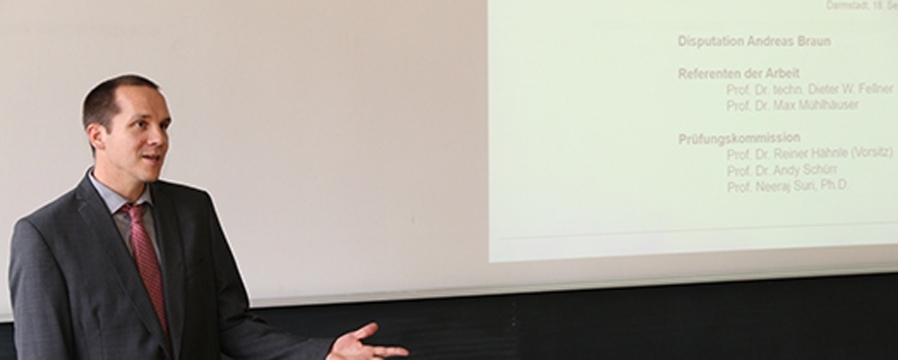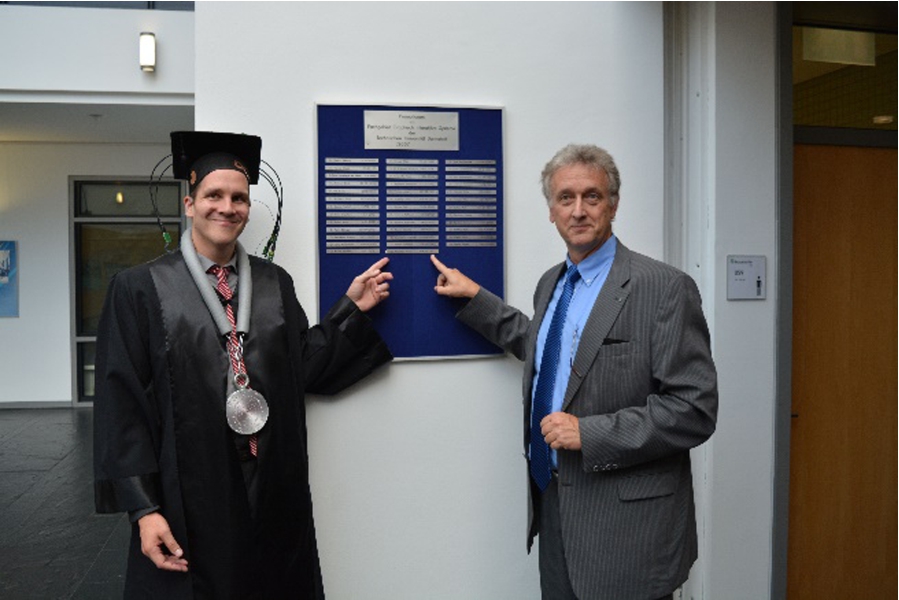Application and validation of capacitive proximity sensing systems in smart environments
The present article summarises the doctoral dissertation of Andreas Braun.
On September 18, 2014 in Darmstadt Germany, Andreas Braun successfully defended his PhD thesis entitled “Application and validation of capacitive proximity sensing systems in smart environments” [1]. The primary supervisor was Dieter W. Fellner, the secondary supervisor Max Mühlhäuser. The examination committee consisted of the supervisors, was chaired by Reiner Hähnle, and included Andy Schürr and Neeraj Suri. The degree was awarded with honours. The viva took place in a public presentation on the premises of Technische Universität Darmstadt (Figs 1 and 2).
1.Thesis summary
Smart environments feature a number of computing and sensing devices that support occupants in performing their tasks. In the last decades, there has been a multitude of advances in miniaturizing sensors and computers, while greatly increasing their performance. As a result new devices are introduced into our daily lives that have a plethora of functions. Gathering information about the occupants is fundamental in adapting the smart environment according to preference and situation. There is a large number of different sensing devices available that can provide information about the user. They include cameras, accelerometers, GPS, acoustic systems, or capacitive sensors. The latter use the properties of an electric field to sense presence and properties of conductive objects within range. They are commonly employed in finger-controlled touch screens that are present in billions of devices. A less common variety is the capacitive proximity sensor. It can detect the presence of the human body over a distance, providing interesting applications in smart environments. Choosing the right sensor technology is an important decision in designing a smart environment application. Apart from looking at previous use cases, this process can be supported by providing more formal methods.
Fig. 1.
Dr. Andreas Braun during the viva.

Fig. 2.
Supervisor Prof. Dr. Dieter W. Fellner (right) and Dr. Andreas Braun.

This thesis presents a benchmarking model that is designed to support this decision process for applications in smart environments [2]. Previous benchmarks for pervasive systems have been adapted towards sensors systems and include metrics that are specific for smart environments. Based on distinct sensor characteristics, different ratings are used as weighting factors in calculating a benchmarking score. The method is verified using popularity matching in two scientific databases. Additionally, there are extensions to cope with central tendency bias and normalization with regards to average feature rating. Four relevant application areas are identified by applying this benchmark to applications in smart environments and capacitive proximity sensors. They are indoor localization, smart appliances, physiological sensing, and gesture interaction. Any application area has a set of challenges regarding the required sensor technology, layout of the systems, and processing, that can be tackled using various new or improved methods. The thesis presents a collection of existing and novel methods that support processing data generated by capacitive proximity sensors. These are in the areas of sparsely distributed sensors [3–5], model-driven fitting methods [3,6], heterogeneous sensor systems [7,8], image-based processing [8], and physiological signal processing [3,9]. To evaluate the feasibility of these methods, several prototypes have been created and tested for performance and usability. Six of them are presented in detail. Based on these evaluations and the knowledge generated in the design process, capacitive proximity sensing in smart environments is classified. This consists of a comparison to other popular sensing technologies in smart environments, the major benefits of capacitive proximity sensors, and their limitations [10]. In order to support parties interested in developing smart environment applications using capacitive proximity sensors, a set of guidelines is presented that support the decision process from technology selection, to choice of processing methods.
References
1 | [[1]] A. Braun, Application and validation of capacitive proximity sensing systems in smart environments, 2014, Doctoral dissertation, Technische Universität Darmstadt, http://tuprints.ulb.tu-darmstadt.de/4175/. |
2 | [[2]] A. Braun, R. Wichert, A. Kuijper and D.W. Fellner, A benchmarking model for sensors in smart environments, in: Proceedings AmI International, (2014) , pp. 242–257. |
3 | [[3]] A. Braun, S. Frank and R. Wichert, The capacitive chair, Lecture Notes in Computer Science 9189: ((2015) ), 397–407. |
4 | [[4]] A. Braun and P. Hamisu, Designing a multi-purpose capacitive proximity sensing input device, in: Proceedings PETRA, (2011) , Article No. 15. |
5 | [[5]] A. Braun, H. Heggen and R. Wichert, CapFloor – a flexible capacitive indoor localization system, in: Proceedings Evaluating AAL Systems Through Competitive Benchmarking. Indoor Localization and Tracking, (2012) , pp. 26–35. |
6 | [[6]] A. Braun and H. Heggen, Context recognition using capacitive sensor arrays in beds, in: Technik für ein selbstbestimmtes Leben – 5. Deutscher AAL-Kongress, VDE Verlag, (2012) . |
7 | [[7]] A. Braun, S. Neumann, S. Schmidt, R. Wichert and A. Kuijper, Towards interactive car interiors – the Active Armrest, in: Proc. of the 8th Nordic Conference on Human-Computer Interaction: Fun, Fast, Foundational, (2014) , pp. 911–914. |
8 | [[8]] A. Braun, S. Zander-Walz, S. Krepp, S. Rus, R. Wichert and A. Kuijper, CapTap – combining capacitive gesture recognition and knock detection, 2015, Working paper. |
9 | [[9]] M. Djakow, A. Braun and A. Marinc, MoviBed – sleep analysis using capacitive sensors, Lecture Notes in Computer Science 8516: ((2014) ), 171–181. |
10 | [[10]] A. Braun, R. Wichert, A. Kuijper and D.W. Fellner, Capacitive proximity sensing in smart environments, Journal of Ambient Intelligence and Smart Environments 4 (2015). |




